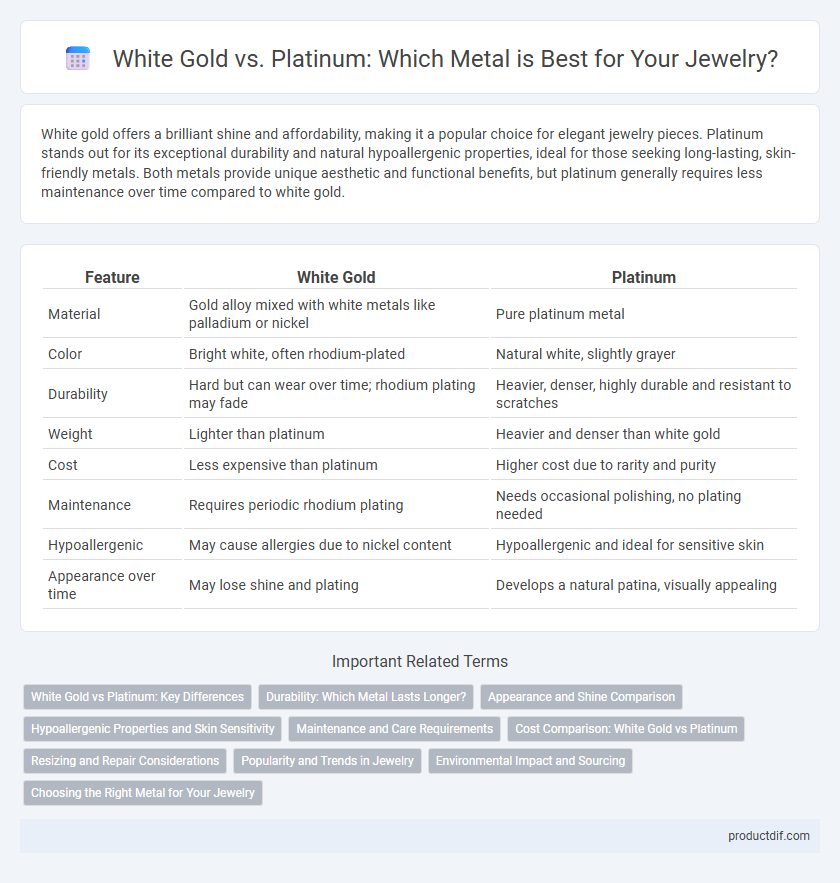White gold offers a brilliant shine and affordability, making it a popular choice for elegant jewelry pieces. Platinum stands out for its exceptional durability and natural hypoallergenic properties, ideal for those seeking long-lasting, skin-friendly metals. Both metals provide unique aesthetic and functional benefits, but platinum generally requires less maintenance over time compared to white gold.
Table of Comparison
| Feature | White Gold | Platinum |
|---|---|---|
| Material | Gold alloy mixed with white metals like palladium or nickel | Pure platinum metal |
| Color | Bright white, often rhodium-plated | Natural white, slightly grayer |
| Durability | Hard but can wear over time; rhodium plating may fade | Heavier, denser, highly durable and resistant to scratches |
| Weight | Lighter than platinum | Heavier and denser than white gold |
| Cost | Less expensive than platinum | Higher cost due to rarity and purity |
| Maintenance | Requires periodic rhodium plating | Needs occasional polishing, no plating needed |
| Hypoallergenic | May cause allergies due to nickel content | Hypoallergenic and ideal for sensitive skin |
| Appearance over time | May lose shine and plating | Develops a natural patina, visually appealing |
White Gold vs Platinum: Key Differences
White gold and platinum differ primarily in composition and durability; white gold is an alloy of gold mixed with metals like nickel or palladium, while platinum is a naturally white, dense metal. White gold is often coated with rhodium to enhance its shine and resist scratches, whereas platinum develops a patina over time, offering a unique, aged look. Cost-wise, platinum generally commands a higher price due to its rarity and density, making it a premium choice for jewelry such as engagement rings and luxury watches.
Durability: Which Metal Lasts Longer?
Platinum is known for its exceptional durability and resistance to wear, making it ideal for jewelry pieces that require long-term strength and resilience. White gold, although strong, is alloyed with other metals and usually coated with rhodium to enhance its durability, but it may require re-plating over time to maintain its appearance. Platinum's density and natural resistance to scratching ensure it typically lasts longer than white gold in everyday wear.
Appearance and Shine Comparison
White gold features a warmer tone with a subtle yellowish hue due to its gold content, while platinum boasts a naturally bright, silvery-white appearance that remains consistent over time. The shine of white gold is enhanced by a rhodium plating, which can wear off and require reapplication, whereas platinum maintains its lustrous polish without additional coatings. Over time, platinum develops a distinctive patina, offering a vintage charm that contrasts with the high-gloss finish of freshly plated white gold.
Hypoallergenic Properties and Skin Sensitivity
White gold often contains nickel, which can cause allergic reactions in sensitive skin, whereas platinum is naturally hypoallergenic and less likely to provoke irritation. Platinum's dense and pure composition makes it ideal for those with metal allergies or skin sensitivities. Choosing platinum over white gold reduces the risk of redness, itching, and other skin reactions linked to metal allergens.
Maintenance and Care Requirements
White gold requires periodic rhodium plating to maintain its bright white finish, as the natural alloy tends to yellow over time due to exposure and wear. Platinum, with its dense and durable nature, develops a characteristic patina that enhances its appearance and requires only occasional polishing to retain its luster. Regular cleaning with mild soap and a soft brush is recommended for both metals to preserve shine and prevent dirt buildup, but platinum generally demands less intensive upkeep compared to white gold.
Cost Comparison: White Gold vs Platinum
White gold typically costs less than platinum due to its alloy composition, which includes less expensive metals like nickel or palladium, while platinum is a naturally rarer and denser metal, contributing to its higher price. The cost difference often ranges from 30% to 50%, with platinum jewelry commanding a premium because of its durability and weight. Buyers should consider long-term value, as platinum's resistance to tarnish and wear can justify the initial higher investment compared to white gold.
Resizing and Repair Considerations
White gold requires more frequent resizing due to its softer alloy composition, making it easier to alter but prone to wear over time. Platinum's dense and durable nature complicates resizing and repairs, often demanding specialized techniques and tools to avoid damage. Both metals need professional craftsmanship to maintain structural integrity and aesthetic quality during resizing and repairs.
Popularity and Trends in Jewelry
White gold and platinum remain top choices in jewelry for their durability and aesthetic appeal, with white gold favored for its affordability and widespread availability. Platinum, known for its rarity and hypoallergenic properties, appeals to consumers seeking luxury and long-lasting value. Current trends show a resurgence in platinum's popularity, driven by its association with high-end, timeless pieces in engagement rings and designer collections.
Environmental Impact and Sourcing
White gold requires alloying with other metals like nickel or palladium, which involves mining processes that impact ecosystems and contribute to carbon emissions; refining techniques may also use hazardous chemicals. Platinum is rarer and mined from limited locations, often South Africa and Russia, where extraction is energy-intensive and linked to significant environmental degradation and water pollution. Sustainable sourcing initiatives for both metals aim to reduce ecological damage, promoting recycled materials and traceable supply chains in the jewelry industry.
Choosing the Right Metal for Your Jewelry
White gold offers a more affordable option with a warm tone enhanced by rhodium plating, making it ideal for those seeking elegance and durability. Platinum, known for its natural white sheen and superior resistance to tarnish and wear, is a premium choice favored for its hypoallergenic properties and long-lasting strength. Selecting between white gold and platinum depends on budget, skin sensitivity, and the desired balance between maintenance and longevity in your jewelry collection.
White Gold vs Platinum Infographic

 productdif.com
productdif.com